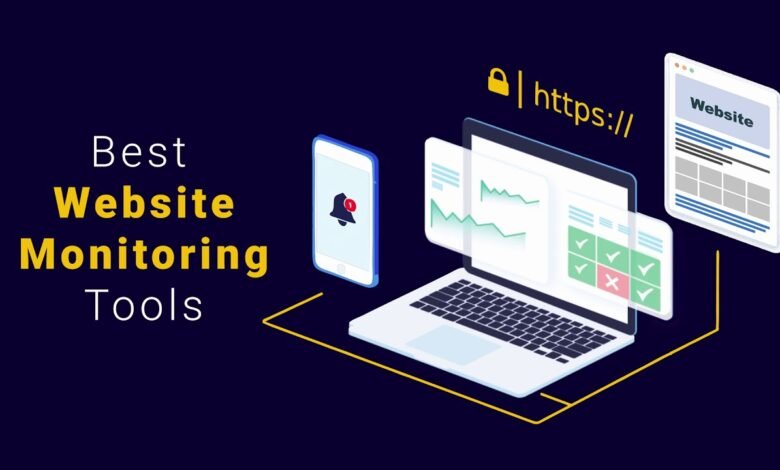Improve Performance with Real-Time Website Monitoring

In today’s fast-paced digital environment, every second counts. If your website is slow or unresponsive for a moment it could mean lost customers, missed sales, and a damaged reputation. This is where real-time website monitoring plays a crucial role. It ensures that your site is performing at its best, every minute of the day, by checking it constantly and alerting you if something goes wrong.
Real-time monitoring is more than just a technical add-onit’s a strategic advantage. By keeping a watchful eye on your website’s uptime, speed, and server health, businesses can detect issues before they affect the user experience. This kind of proactive approach is key to building trust with visitors and staying ahead of the competition in 2025.
Let’s explore how real-time website monitoring can improve your site’s performance and why it’s becoming an essential part of every online strategy.
1. Avoid Downtime Before It Hurts Your Business
Unexpected downtime is one of the biggest threats to any online business. Whether you’re running an eCommerce platform, a service site, or a content blog, users expect your website to be available 24/7.
Real-time website monitoring tools work behind the scenes to test your site every minute. If your server goes down or your site becomes unreachable, you’ll be notified instantly. This early warning system lets you respond quickly sometimes before your users even notice there was a problem.
By minimizing downtime, you reduce the risk of losing customers and protect your online reputation.
2. Optimize User Experience
A slow-loading site is just as damaging as a website that’s offline. Visitors today are less patient than ever; if a page takes more than 2-3 seconds to load, most users will leave and never come back.
Monitoring tools help you track your website’s speed and responsiveness across different times, locations, and devices. You can analyze the data to find performance bottlenecks and fix them before they impact your users.
In essence, these tools help you deliver a smooth, fast experience that keeps people engaged and coming back.
3. Monitor Global Performance in Real-Time
If your business serves customers in multiple countries, global performance becomes even more important. A page that loads quickly in New York might lag in Singapore.
Real-time website monitoring services often include global testing nodes that simulate visits from various regions. This helps you understand how your website performs across the world and gives you the insights you need to optimize content delivery, server routing, or hosting solutions.
Knowing exactly where your site is slow allows for more accurate, effective improvements.
4. Detect and Fix SSL Issues
Security is non-negotiable in 2025. A broken SSL certificate not only makes your website look untrustworthy, it can actively block users from visiting your site.
Monitoring tools now include SSL tracking features, alerting you when your SSL certificate is about to expire or becomes invalid. This protects your site from being flagged as “Not Secure” by browsers and search engines, maintaining both safety and credibility.
Better yet, early alerts give you time to renew or replace certificates without disruption.
5. Track Uptime Trends Over Time
Real-time monitoring is also useful for long-term performance analysis. These tools often provide detailed reports showing how often your site has been up (or down), what caused issues, and how long it took to resolve them.
This data helps you identify trends, such as recurring server issues or times of day when your traffic slows down performance. You can use this information to upgrade your hosting plan, switch providers, or optimize your backend processes.
Having real data at your fingertips means smarter decisions for your website’s infrastructure.
6. Enhance SEO Through Better Uptime
Search engines favor websites that are fast and reliable. Google, for example, includes page speed and uptime in its ranking algorithms.
If your website is frequently downor even slowit could hurt your position in search results. This makes it harder for potential customers to find you.
Using a website monitoring service keeps your site running smoothly and alerts you to performance issues that could affect your SEO. It’s a small tool with a major impact on visibility and traffic.
7. Improve Communication with Public Status Pages
Many real-time monitoring tools now offer public status pages. These are online dashboards where visitors can check the health of your website or services in real time.
Instead of receiving complaints through customer service when something goes wrong, your users can simply check the status page for updates. This builds transparency and reduces frustration, especially during maintenance or unexpected downtime.
Public status pages show that you care about user experience and are committed to staying transparent.
8. Stay Ahead with Automation and Integration
Modern website monitoring platforms integrate with popular tools like Slack, Microsoft Teams, and various ticketing systems. This means that alerts can be routed directly to your IT team, customer support, or development team.
The result is faster response time, better collaboration, and less downtime overall. In 2025, automation and integration are not just helpful, they’re expected.
Read Also: Top Digital Marketing Company in India Today
Conclusion
Your website is the digital face of your business, and in a competitive online world, performance is everything. Real-time website monitoring ensures that your site remains fast, secure, and always available. It gives you the ability to detect issues early, make informed decisions, and maintain trust with your users.
From reducing downtime to boosting SEO, the benefits are clear. Don’t wait until something breaksstart monitoring your site today and stay one step ahead of the problem.
If you care about your site’s performance, reputation, and customer experience, then website monitoring isn’t optional, it’s essential.




